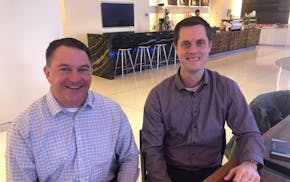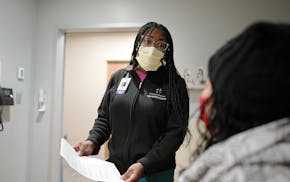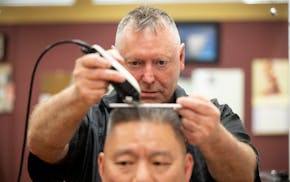Just as my dad was the last one on the block to buy a color TV 40 years ago, I'm usually last to jump on the latest-hot-tech-thing bandwagon.
I'm a classic late adapter. And pretty thrifty.
The VCR, microwave and other stuff worked well — and were a lot cheaper — by the time I bought.
I sure wasn't first in line for the recent spate of virtual-reality arcades. It took a thoughtful young guy who quit a lucrative job at a local investment bank and launched a "VR lab" for me to show up for a tour last month of this tech-entertainment trend.
It's the several-month-old REM5 VR Lab in St. Louis Park.
" 'Eat, drink and VR' is our motto," said Amir Berenjian, one of three partners at REM5, located in a refurbished St. Louis Park warehouse space.
Berenjian and his partners have developed a virtual-reality studio where corporate groups or a family of four can eat pizza and wage virtual war on zombies, scale Mount Everest or explore under the ocean for about $100 an hour.
"We're already positive cash flow," Berenjian said. "Most of the [software] content is built for entertainment."
This is a long way from that View-Master we had when I was a kid in the 1960s.
"Our favorite thing is birthday parties," Berenjian reported. "The kids have a blast. The next week we have the parents and their friends for 90 minutes of VR, pizza and beer."
A break from banking
Berenjian, 35, an investment banker at the former Greene Holcomb Fisher, decided to resign in December 2016. He was supposed to fly out to New York for new parent company BMO's holiday party, but looked at his young family and decided to stay home.
Several months earlier, Berenjian, a University of Minnesota business graduate, realized he was going to have to spend a lot more time on the road because of the BMO takeover, and work even longer hours than normal chasing larger deals to make the same six-figure compensation he made at Greene Holcomb.
His old partners are doing just fine at BMO amid the continuing strong trade of buying and selling companies.
Berenjian is the son of an Iranian immigrant who studied computer science at the U, married a woman from Anoka, raised kids and did well at Control Data and Polar Semiconductor.
Amir Berenjian, who leans toward jeans and a baseball cap, wasn't raised to blow all his pay on a palace, travel and luxury items. He had savings and an entrepreneurial streak.
Berenjian had long discussed a future with old friend Travis Hoium, an engineering graduate and MBA out of the U who once worked at 3M.
"We lived downtown, worked hard, went out on the town and would argue about potential business ideas," Berenjian recalled of their bachelorhood of a decade ago.
VR "arcades'' started popping up around town and the world. Most were targeted at kids and gaming business. There are low-end systems for a few hundred bucks for at-home use. The type used at REM5 run close to $5,000. So far, most consumers would rather rent than own one.
Bijan Berenjian, 29, Amir's brother and a veteran of the restaurant industry, joined REM5 as a minority owner to run the food end of the business.
The family-and-friends owners of this business have invested about $500,000, including a bank loan, to get things up and running.
REM5 employs 10 people.
The owners are already thinking about what's next. The software manufacturers have focused on entertainment, but REM5's owners want to increase business during the day. (REM in their name stands for "rapid eye movement," the sleep stage when most dreaming occurs.)
Education and empathy
The REM5 crew thinks the future is education and empathy programming that will help fill their daytime hours with seniors, students, trainers and workers.
For example, they have played host to a 93-year-old woman for a free "visit" to the village in Norway, thanks to a Google Earth program, where her granddaughter was wed. The grandma wasn't up to the trip.
There's a program that helps people understand how easy it is to lose an apartment and go homeless; what it's like to be a woman in a meeting full of men, or to be transgender for a day; and one on how to cope with a potentially violent situation.
The homelessness program was good. It certainly wasn't as credible as the real experiences I've had with homeless people, including a once-prominent architect who was fired and tossed out of his West Bloomington house and landed on the streets amid mental health and drug problems.
Still, the VR program is a fine entry into the subject, and has tremendous potential as a training tool.
"We think the next wave of this business will be about training and things that help people empathize," Hoium said.
And whatever it takes, virtual or real, for us to walk a mile in another's shoes is surely a good thing.

St. Anthony: 'Patient' investing paying off for St. Paul's Hill Capital

Jennifer Smith, leader of Burnsville's Innovative Office Solutions, has died

St. Anthony: Medical professions in Minnesota need more people of color in their ranks



